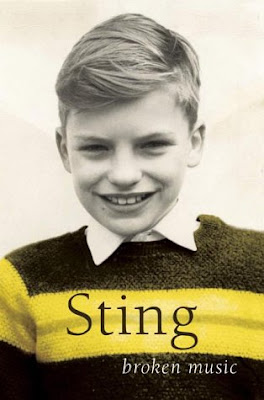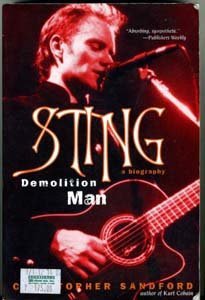Almost Melodic Reading
 Part of a minor shopping spree at PageOne in Hong Kong last ’05 was a copy of Sting’s biography, “Broken Music.” Released back in 2003 in Great Britain, it took a couple of years to reach Asia, and probably the rest of the globe since it was at about this time that I caught Mr. Sumner guesting in Oprah, most likely to peddle his memoir.
Part of a minor shopping spree at PageOne in Hong Kong last ’05 was a copy of Sting’s biography, “Broken Music.” Released back in 2003 in Great Britain, it took a couple of years to reach Asia, and probably the rest of the globe since it was at about this time that I caught Mr. Sumner guesting in Oprah, most likely to peddle his memoir.While I admit to being a massive Sting fan, more so as a solo artist than in the Police, I did let “Broken Music” gather a bit of dust on my shelf until I brought it with me to Macau. Intending to merely let it fill in airport waiting time, and the occasional lull in-between tourist spots, “Broken Music” gave this reader a whole new level of fascination for Mr. Gordon Sumner. So much so that my engrossment caused me to not notice that I already got left behind once by the bus for the city tour.
Segueway: The whole Macau affair was sponsored by Banbros Commercial, Incorporated, the Philippines’ exclusive distributor of Altec Lansing speakers, and the one of two distributors of ASUS products. Supposedly to reward loyal dealers like our Exponent Enterprises division in Baguio City. Thanks, Boss Mike!
Aaaaaaanyways… on to the books…!
Sting uses his excursion to a Brazilian rain forest with its inclusive swig of the exotic Ayahuasca brew as a literary trigger to kick off his flashbacks. This is where we sort of figure that given the way Sting describes his mother, Audrey, one is tempted to think that little Gordon seems to have some sort of Oedipus fetish (or complex) over his self-confessed maternal first muse.
But stupid and pointless insinuations aside, “Broken Music” provides a dreamy, atmospheric, yet stark narrative of Sting’s early life to the first few cracks of massive global fame of his “Police” days. Sting details much of his rise, including his poignant days with “Last Exit,” the band he was part of along with keyboard player Gerry Richardson, who he became good friends with. Sting even gives out the rare peek into the rather earnest personality of erstwhile band member Henry Padovani and the French guitarist’s self-described “really moments.” Glossing over such things as fan-speculated band dynamics, while pointing out highlights on the “Police’s” astronomic climb, Sting tells enough “Police” story to carry his yarn along, but not enough to cause the wide-eyed fan (like yours truly) to salivate for more “Police” details. Most likely leaving it for a possible sequel, or perhaps quietly suggesting that “Police”-starved readers pick up his band-mate, Stewart Copeland’s “Everyone Stares,” first-person rock-umentary video.
Whereas autobiographies of singer-songwriters are usually interesting reading, “Broken Music” stands out with its author’s nigh god-like command of the written word (or spoken, or sung, for that matter). His story-telling powers make otherwise mundane events sparkle like mined rocks encrusted with multi-faceted gems in a rainbow of reflected colors and tinted nuances.
And while there is frankly not enough about his music in these pages (for me anyways), it does give a loyal fan like me profound insight on this bard, who has painted his own portrait in a canvass that is almost larger-than-life.
As a fan, I enjoyed it immensely. Granted, I found the Rio de Janeiro intro device a bit cumbersome, it nonetheless sets matters firmly into this reader’s mind that what I am leafing through will not be a mere VH1 rerun.
-
For those who are not diehards, I would recommend “Broken Music” if only for its excellence as a purely literary piece. Because after the fog machines have stopped smoking, the spotlights have been shut off, and the star-struck trivia-hunting scavenger has tired of trying to find skeletons in Sting’s proverbial closet, “Broken Music” is quite simply a damn good, well-written story.
Delayed Book Review: “Sting, Demolition Man” by Christopher Sandford
Entertaining, and Un-Demolishing
 Whereas “Broken Music” had the benefit of Sting’s name as author emblazoned on the cover over the novelty of a young photograph of the rock demi-god, Sandford’s “Demolition Man” had to resort to slapping what I can assume to be a stock image of Sting in concert on the cover, along with a rather pedestrian choice of typefaces.
Whereas “Broken Music” had the benefit of Sting’s name as author emblazoned on the cover over the novelty of a young photograph of the rock demi-god, Sandford’s “Demolition Man” had to resort to slapping what I can assume to be a stock image of Sting in concert on the cover, along with a rather pedestrian choice of typefaces.I can go on about my personal criticisms of un-elegance in its book design, but I must admit that “Demolition Man” did entertain. Of course, my having read “Broken Music” almost a year prior to this volume may have been a factor in coloring and diluting my appreciation of Sandford’s literary efforts. It does not take away the realization that a handful of chapters into “Demolition Man,” one concludes that Sandford really did do his homework, although one might question the credibility of his sources.
After peeking into the mostly negative reviews of Sandford’s succinctly titled biography “Kurt Cobain,” and other rather modestly received biographies, I approached this book with caution.
“Demolition Man” actually reads more like a personal commentary from Sandford, who sounds very much like an honest fan, almost venerating Sting for all the rock demi-god’s supposedly much-deserved egomania. He, of course peppers this with quotes from various magazines, along with statements from the various aforementioned supposedly reliable sources. With a huge bulk of the texts reflecting Sandford’s work as a music critic, wherein he pores over rather subjective opinions and critiques regarding Sting’s music.
“Demolition Man” works more as a collated scrap book that entertains, slightly informs, but never reaches its aspiration to become a genuine volume of reference. Nonetheless, it was a more than decent complement to “Broken Music.” But read alone, its only greatest revelation is how big a Sting fan Sandford is.


No comments:
Post a Comment